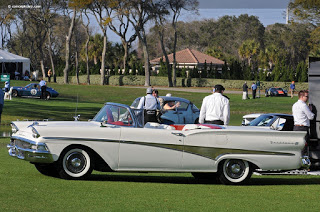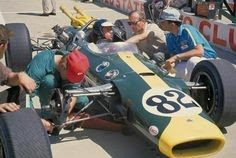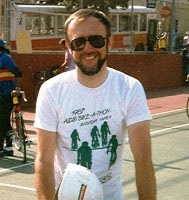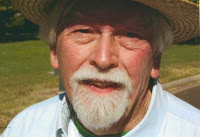True Colors, by Nicholas
Take a Walk in the Grove
The Grove started with one man’s vision. Doug McNeil knew of the memorial grove in Golden Gate Park in San Francisco and asked, literally as his dying wish, why can’t Denver create such a spot. Doug died of AIDS in 1993, a time when the LGBT community was focused more on the battle to undo the infamous Amendment 2 than on the AIDS epidemic. Amendment 2, passed by Colorado voters in 1992, prohibited any government or government agency in this state from enacting any provisions to ban discrimination against lesbian and gay people. (There’s an excellent exhibition on that history outside this door in The Center’s lobby.) And it was a time of still rampant AIDS phobia.
A small group of Doug’s friends vowed to carry out his dream for The Grove. They weren’t the usual gaggle of community activists and politicos. They included socialites, arts community supporters, an attorney, and an Episcopal priest. Most were not gay. They organized a non-profit group called The Grove Project, got 501c3 IRS status so they could collect funds, and began the long process of taking on the bureaucracy of the city’s Parks Department.
The Parks Department never openly rejected the idea but negotiations dragged on for years. At first, the area in front of the performing arts complex on Speer Blvd was proposed. The city objected that theatre and concert goers wouldn’t want to be reminded of the awfulness of AIDS on their nights out on the town. Another location in a park in southeast Denver was suggested but that would have left the memorial far from the Capitol Hill neighborhood that was most affected by AIDS.
At some point, the riverfront came into the discussion. At that time, the area was just beginning to be developed. There was a quiet, somewhat out of the way spot in a new park—Commons Park—that the city was planning. That fit the criteria of being visible, centrally located and quiet enough to promote the atmosphere desired.
The Grove was envisioned to be a natural area for contemplation. It was landscaped very simply with trees, natural grasses and shrubs, and some rocks. A simple inscription reads: “Dedicated to the remembrance of those who have lost their lives to AIDS and to their loving caregivers who helped them live out those lives with dignity.”
The Grove was dedicated in a simple ceremony in August 2000. Doug McNeil’s loyal and persistent friends accomplished his dream after seven years of work.
Now, The Grove sits largely ignored and sort of neglected in a recessed corner of Commons Park, near 15th Street and Little Raven Street. It is surrounded by high priced condos and apartments but it is still a quiet and attractive area.
Recently, a movement got underway to renew the spot, clean it up, refresh the landscaping and, most importantly, make the community aware that this historical and spiritual resource exists. In recalling all the individuals who battled, and continue to battle AIDS, we remember how our community grew from that experience. We remember those we’ve lost. We remember when being gay changed from just giving the most fabulous parties to a truly mature community of caregivers and advocates. We remember our past and that we have a history. A history that is the root of our present and future.
I encourage everyone to seek out The Grove and spend a few quiet moments there remembering. And maybe you can help in its renewal. You too can show your true colors.
© 2016
True Colors, by Gillian
Tricky things, true colors.
© February 2016
About the Author
I was born and raised in England. After graduation from college there, I moved to the U.S. and, having discovered Colorado, never left. I have lived in the Denver-Boulder area since 1965, working for 30 years at IBM. I married, raised four stepchildren, then got divorced after finally, in my forties, accepting myself as a lesbian. I have been with my wonderful partner Betsy for thirty years. We have been married since 2013.
True Colors, by Ray S.
Tin Pan Alley—that was when popular music lovers were still buying sheet music
and the latest 78 RPM records. Our subject “True Colors” reminded me of a song
titled “The Night that You Told Me Those
Little White Lies.”
able to hear your thoughts (and/or maybe confessions) about True Colors.
liberal (no pun intended) number of patriotic red, white, and blue references
as well as our tribe’s Rainbow flag palette.
I am, my dominant thoughts promptly unearthed a lifetime of lots of little white
lies and a few under the heading shady black. So many that it is very difficult
to recall when and if any true colors of virtue stand out. I can’t recall when
I had occasion to show those True Colors. I don’t believe I am alone in this
category.
colors when you were confirmed in a faith and didn’t really know what all of
that stuff was about, but maybe you were cleansed of everyone else’s sins, or
swore secret allegiance to some quasi lodge, fraternity, sorority, high school
clique. Mind you, I do not disrespect the various Orders’ goals; it is just the
way we obey. True Colors where are you when needed?
always subject to slight adjustments or reinterpretations as the times and
circumstances demand.
crossed way down deep at your wedding? True colors prevailed with pride
(depending if it was unintended) and love upon the arrival of the baby girl or
boy. Color me pink or color me blue—lavender came later.
showing of true colors, one of celebration and liberation, after a long
struggle finding our way out of the blackness of many closets, the Coming Out
we all rejoice in, with the True Colors of the beautiful rainbow.
the Author
True Colors, by Pat Gourley
you
them show
by Billy Steinberg and Tom Kelly.
to the song True Colors made a famous
hit by Cyndi Lauper back in 1986 you can see why it has been adapted as a Queer
anthem and especially by certain LGBT youth groups. A great coming out song if
there ever was one.
wrote the song about his mother. Later modified by Tom Kelly and picked up,
when offered, by Cyndi Lauper. At the time she apparently felt drawn to it
because of the recent death of a friend from AIDS.
Queer people in the past 50+ years or so can be laid squarely at the feet of
our being willing to let our true colors shine through. As has been mentioned
many times in this group and then powerfully validated by our personal stories
it is the individual coming out process that is such a very powerful
change-creating phenomenon.
self-expression that sets us apart from all other minorities and gives us such
power. Also the fact that we are part of and transcend all economic, class and
racial groups gives us a leg up. We are everywhere.
the song brought to it by Lauper has made me wonder about the reason and
implications for recent data on new HIV infections just released last week. In a
story from the Boston Globe published on February 23rd, 2016 they
broke down recent CDC data on projected lifetime risk of HIV among gay men by
race.
say the least. Overall risk for HIV infection among Americans as a whole has
decreased. The risk of infection was 1 in 78. It has now decreased to 1 in 99
for the U.S. population. However, per the CDC report the lifetime risk for
queer men is 1 in 6, overwhelmingly greater than for the population as a whole.
That is amazing enough but where it gets truly shocking is in the racial
disparity for gay men. The lifetime risk for black gay men is 1 in 2, for
Latinos it is 1 in 4 and for white gay men 1 in 11.
surprising the greatest risk for black gay men is in southern states but the
highest risk is in the District of Columbia. As depressing as this news is it
actually reflects an improvement over the past but still unacceptably bad.
certain prevention challenges for the gay African American community were
identified. These were: socioeconomic factors, smaller and more exclusive
sexual networks, sexual relations with older men, lack of awareness of HIV
status and stigma, homophobia and discrimination. I would hope that these “prevention
challenges” are ones that have been identified by community-based black gay men
themselves and not pronouncements that have come down from on high by CDC AIDS
specialists.
broader queer community can do to help reverse these dismal statistics? A first
step might be taking a hard look at how significant racism is still a reality
within the queer community particularly and what am I doing personally to
address any latent racism I may harbor.
in a non-threatening manner for the queer black community to develop and thrive
and what is needed from the broader queer community to facilitate this happening?
Perhaps this just involves our ongoing participation in the struggle for peace
and social justice.
cop-out response to these stats by saying well it is the homophobia within the
broader African American community that is responsible for this. Most of us
have come out of families and communities less that welcoming of our queerness
if not out right hostile. Something else has to be going on here. At the very
least these extremely sobering AIDS statistics need to be a reason for pause
and sincere soul searching certainly by gay white men looking sincerely at how we
might be part of the problem too.
is the creation of a society where everyone’s true colors can shine
through from cradle to grave.
the Author
by Holy Cross nuns. The bulk of my adult life, some 40 plus years, was spent in
Denver, Colorado as a nurse, gardener and gay/AIDS activist. I have currently returned to Denver after an
extended sabbatical in San Francisco, California.
True Colors, by Ricky
Oh say, what is truth? Can you describe for me what color is? Is it true that we all see the same color when looking at an object? Can colors lie? In normal daylight my car looks to be colored either burgundy or brown depending upon what angle one is looking at the vehicle. In twilight, it looks black. So what is the color of my car? Is it burgundy, brown, or black? Officially the manufacturer states the color is burgundy. Thus under different lighting conditions and angles the color shifts, in essence, lying about itself.
© 29 February 2016
About the Author
I was born in June of 1948 in Los Angeles, living first in Lawndale and then in Redondo Beach. Just prior to turning 8 years old in 1956, I began living with my grandparents on their farm in Isanti County, Minnesota for two years during which time my parents divorced.
When united with my mother and stepfather two years later in 1958, I lived first at Emerald Bay and then at South Lake Tahoe, California, graduating from South Tahoe High School in 1966. After three tours of duty with the Air Force, I moved to Denver, Colorado where I lived with my wife and four children until her passing away from complications of breast cancer four days after the 9-11 terrorist attack.
I came out as a gay man in the summer of 2010. I find writing these memories to be therapeutic.
My story blog is TheTahoeBoy.Blogspot.com
True Colors – Take a Walk in the Grove, by Nicholas
a member of this group. It’s about a group of people who showed their true
colors in their loyalty to one friend and created a unique space for our entire
community. Along the South Platte River on the edge of downtown Denver, is an
area of Commons Park designated as a spot to remember those who have died of
HIV/AIDS and their caregivers. It’s called The Grove and it is one of only two
AIDS memorial gardens in this country—the other is in San Francisco. Our own
Randy Wren was part of that group that labored for seven years to make it
happen.
of the memorial grove in Golden Gate Park in San Francisco and asked, literally
as his dying wish, why can’t Denver create such a spot. Doug died of AIDS in
1993, a time when the LGBT community was focused more on the battle to undo the
infamous Amendment 2 than on the AIDS epidemic. Amendment 2, passed by Colorado
voters in 1992, prohibited any government or government agency in this state
from enacting any provisions to ban discrimination against lesbian and gay
people. (There’s an excellent exhibition on that history outside this door in
The Center’s lobby.) And it was a time of still rampant AIDS phobia.
for The Grove. They weren’t the usual gaggle of community activists and
politicos. They included socialites, arts community supporters, an attorney,
and an Episcopal priest. Most were not gay. They organized a non-profit group
called The Grove Project, got 501c3 IRS status so they could collect funds, and
began the long process of taking on the bureaucracy of the city’s Parks
Department.
negotiations dragged on for years. At first, the area in front of the
performing arts complex on Speer Blvd was proposed. The city objected that
theatre and concert goers wouldn’t want to be reminded of the awfulness of AIDS
on their nights out on the town. Another location in a park in southeast Denver
was suggested but that would have left the memorial far from the Capitol Hill
neighborhood that was most affected by AIDS.
that time, the area was just beginning to be developed. There was a quiet,
somewhat out of the way spot in a new park—Commons Park—that the city was
planning. That fit the criteria of being visible, centrally located and quiet
enough to promote the atmosphere desired.
contemplation. It was landscaped very simply with trees, natural grasses and
shrubs, and some rocks. A simple inscription reads: “Dedicated to the
remembrance of those who have lost their lives to AIDS and to their loving
caregivers who helped them live out those lives with dignity.”
2000. Doug McNeil’s loyal and persistent friends accomplished his dream after
seven years of work.
in a recessed corner of Commons Park, near 15th Street and Little
Raven Street. It is surrounded by high priced condos and apartments but it is
still a quiet and attractive area.
it up, refresh the landscaping and, most importantly, make the community aware
that this historical and spiritual resource exists. In recalling all the
individuals who battled, and continue to battle AIDS, we remember how our community
grew from that experience. We remember those we’ve lost. We remember when being
gay changed from just giving the most fabulous parties to a truly mature
community of caregivers and advocates. We remember our past and that we have a
history. A history that is the root of our present and future.
quiet moments there remembering. And maybe you can help in its renewal. You too
can show your true colors.
the Author
then grew up in San Francisco, and is now growing up in Denver. He retired from
work with non-profits in 2009 and now bicycles, gardens, cooks, does yoga,
writes stories, and loves to go out for coffee.









